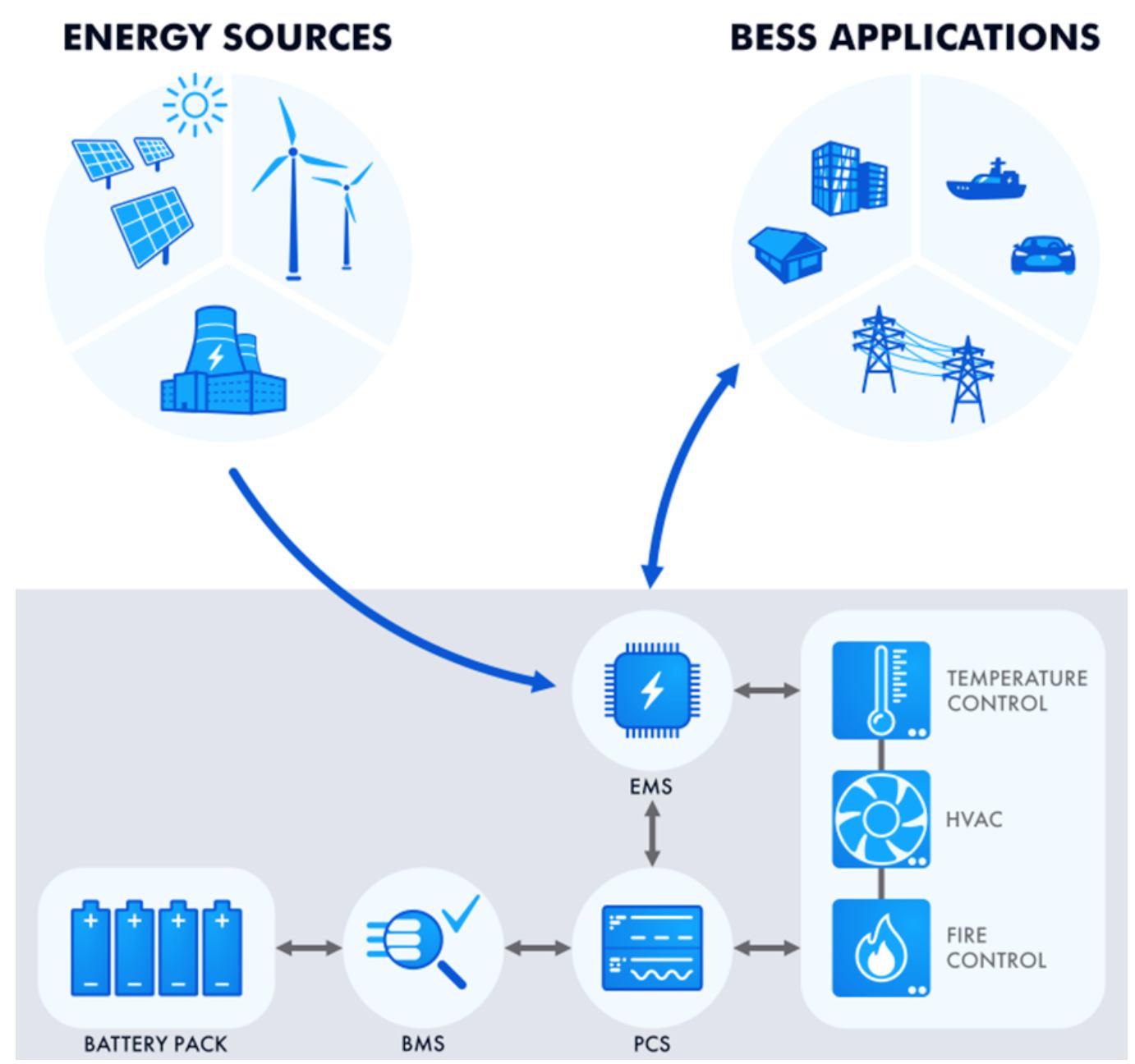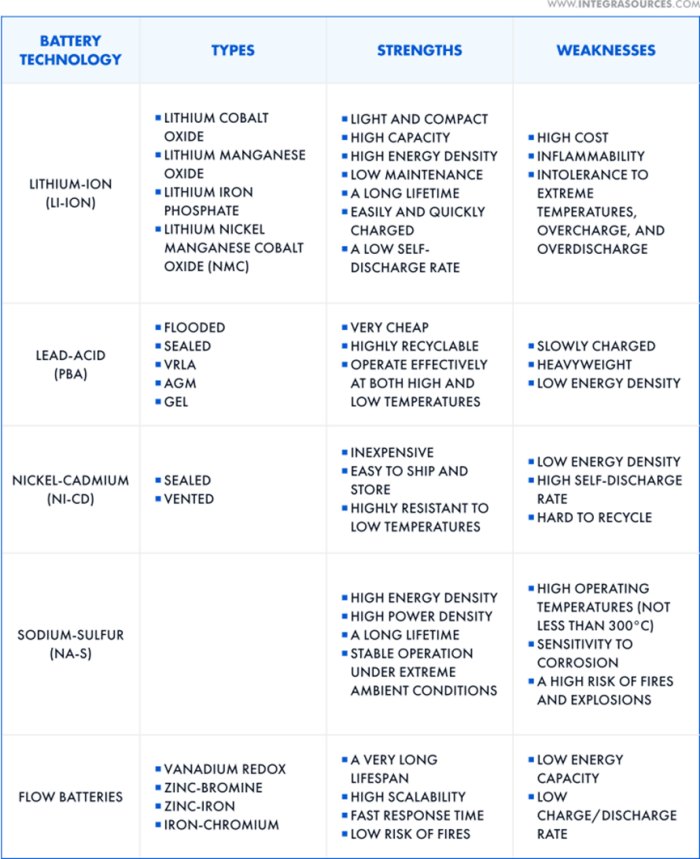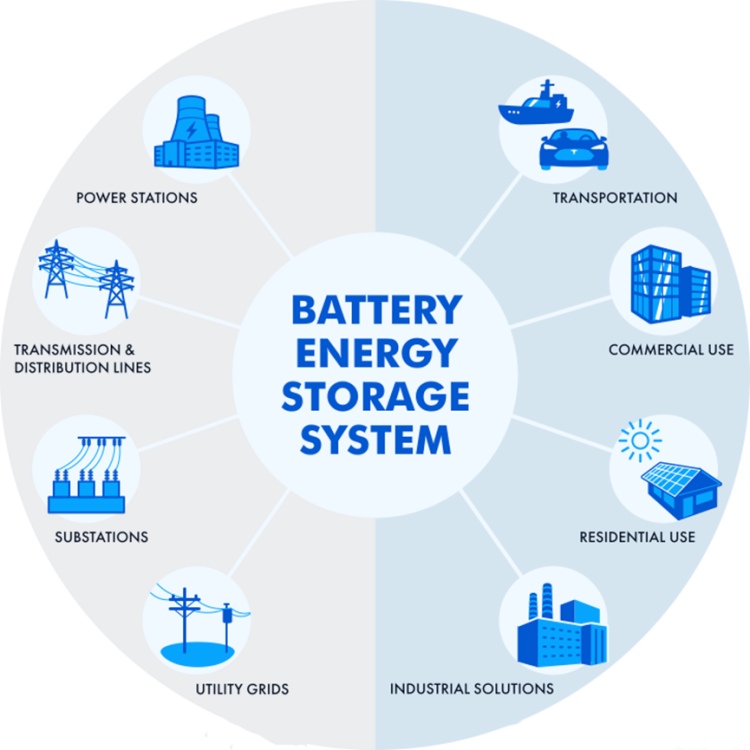BESS is an energy storage system (ESS) that captures energy from different energy sources, accumulates and stores energy in rechargeable batteries for future use. If required, electrochemical energy is discharged from the battery and supplied energy to homes, electric vehicles, industrial and commercial facilities.
BESS is an energy storage system (ESS) that captures energy from different energy sources, accumulates and stores energy in rechargeable batteries for future use. If required, electrochemical energy is discharged from the battery and supplied energy to homes, electric vehicles, industrial and commercial facilities.
A BESS is a composite system, including hardware and basic and advanced software. Major BESS include:
1) Battery system: It contains a single cell that converts chemical energy into electrical energy. The cells are arranged in modules, which form a battery pack. The energy storage battery has a single cell of 3.2V, and Starlight Power provides two nominal models of 48V and 51.2V for customers.
2) Battery Management System (BMS): BMS is used to ensure the safety of the battery system. It monitors the status of battery cells, measures their parameters and status such as state of charge (SOC) and state of health (SOH), and protects batteries from fire and other hazards.
3) Power Conversion System (PCS): Converts the direct current (DC) generated by the battery into alternating current (AC) for use by the facility. The inverter of the battery energy storage system allows the flow of energy in both directions, allowing charging and discharging.
4) Energy Management System (EMS): Responsible for monitoring and controlling the flow of energy within the battery energy storage system. EMS coordinates the work of BMS, PCS and other components of BESS. By collecting and analyzing energy data, EMS can efficiently manage multi-energy access to the system.
In addition to electronic circuits, BESS also relies on powerful software solutions. For example, state-of-the-art systems use machine learning algorithms to optimize energy management. Reliable algorithms and mathematical models need to be established in BMS software development to accurately predict battery status and characteristics.
In summary, BESS collects energy from the grid or renewable energy sources such as solar and wind and stores it using battery storage technology. Energy is released by battery discharge when necessary during peak demand, power outages and various other application scenarios.
The main characteristics of energy storage batteries include:
Storage capacity: This is the amount of charge stored in the battery or the amount of power available in the BESS.
Power: This parameter determines the total power provided by the battery or the output power that the BESS can provide.
Conversion efficiency: This shows the ratio of energy delivered by the battery during discharge to the energy supplied to the battery during charge.
Depth of Discharge (DoD): This shows the percentage of energy released by the battery relative to its total capacity.
Cycle Life: Defined as the number of charge and discharge cycles of a battery, or the amount of energy the battery can provide during its cycel life.
Safety: This is an important feature of batteries.

BESS type:
1) Lithium Ion Battery
According to a report released by the U.S. Energy Information Administration (EIA) in 2020, more than 90% of large-scale battery energy storage systems in the United States are powered by lithium-ion batteries. Starlight energy storage batteries have the characteristics of compact structure, high capacity and energy density, low maintenance cost, long service life, waterproof and dustproof grade 65, and non-flammable. In addition, lithium-ion batteries are easy to charge quickly and have low self-discharge rates.
2) Lead acid battery
Lead-acid batteries are one of the earliest battery technologies and are the cheapest and most common solution used in automobiles, industrial applications and power storage systems. Lead-acid batteries are highly recyclable and operate effectively in both high and low temperatures. Sealed valve-regulated lead-acid (VRLA) batteries are more suitable for power storage solutions than their older counterparts, flooded lead-acid (FLA) batteries, due to their longer life, higher capacity and easier maintenance. Slow charging, heavy weight and low energy density are the main drawbacks of this battery technology.
3) Nickel-cadmium battery (Ni-Cd)
Before lithium-ion batteries entered the market, nickel-cadmium batteries dominated the wearable electronics market. Ni-Cd batteries come in a variety of configurations, they are cheap, easy to transport and store, and have high low temperature resistance. The technology lags behind competing batteries in energy density, self-discharge rate and recycling. Nickel-metal hydride (Ni-MH) batteries use the same component as Ni-Cd technology - nickel hydroxide (NiO(OH)). However, Ni-MH battery chemistry offers better characteristics such as higher capacity and energy density .
4) Sodium-sulfur battery (Na-S)
Sodium-sulfur batteries are a more cost-effective technology based on molten salts. The advantages of Na-S batteries include high energy and power density, long life, and stable operation under extreme environmental conditions. However, this battery technology has limited application scope due to operating at high temperatures (not less than 300°C) and being very sensitive to corrosion. Additionally, sodium is a hazardous ingredient and is highly flammable and explosive. Sodium-sulfur batteries are ideally suited for stand-alone storage applications in conjunction with renewable energy sources.
5) Flow battery
Unlike traditional rechargeable batteries that store energy in solid electrode materials, flow batteries store energy in a liquid electrolyte solution. The most common type of flow battery is the all-vanadium redox battery (VRB). Other types include zinc-bromine, zinc-iron and iron-chromium chemical systems. Despite their low energy capacity and low charge and discharge rates, flow batteries offer several important advantages that allow them to capture a large market share in energy storage systems operating both on and off the grid, including large-scale applications. Advantages include extremely long life (up to 30 years), high scalability, fast response times and low fire risk because flow batteries contain non-flammable electrolytes.

Application of battery energy storage systems
1) Load management (energy demand management)
BESS helps balance the load between peak and off-peak times. Electricity demand may vary depending on day, time, season and other factors. The higher the demand, the higher the cost of electricity, and vice versa - during off-peak periods, prices will be lower. By storing energy when demand is low and discharging it during peak periods, battery energy storage solutions enable users to save on electricity bills (peak shaving).
2) Energy time shift (peak and valley arbitrage)
As mentioned above, electricity prices fluctuate at different times, both rising and falling. Battery storage systems allow energy to be time-shifted—buying energy during off-peak periods and selling or using it when prices rise. Therefore, regardless of the season and electricity demand, BESSs can equalize energy prices and minimize risks.
3) Backup power
In the event of a grid failure, BESS can provide backup power until power is fully restored. Larger energy storage capacity and integration with renewable energy enable BESS to back up energy for longer periods of time. By operating as an uninterruptible power supply (UPS), commercial battery energy storage solutions can save time and money by eliminating downtime.
4) Black start ability
After a power outage, the black-start capability of the battery energy storage system is used to restore power generation, thereby replacing the diesel or natural gas generators used in power plants. The power system can be restarted without the use of external power. BESS's fast response time helps get the system back up and running in the shortest possible time.
5) Frequency control
The battery energy storage system can adjust the grid frequency to ensure that its value is within the specified range. If the amount of electricity produced does not match actual power demand, the frequency may exceed or fall below its rated value. These differences can result in temporary grid disconnections, power failures or power outages. BESS can respond immediately to power outages, provide sub-second frequency speed response, and stabilize the power grid.
6) Renewable energy integration
Combining battery energy storage systems with intermittent renewable energy sources provides cheap, continuous power for grid-connected, off-grid and hybrid systems. Recently, clean energy has become increasingly popular as an alternative to fossil fuels because it is economically viable and environmentally friendly. According to the International Energy Agency (IEA), renewable energy's share of global electricity production increased from 27% in 2019 to 29% in 2020. In addition, it is expected that the proportion of renewable energy will reach 45% by 2040. Government subsidies and reduced tax rates have led to widespread support and incentives for renewable energy-storage solutions.
